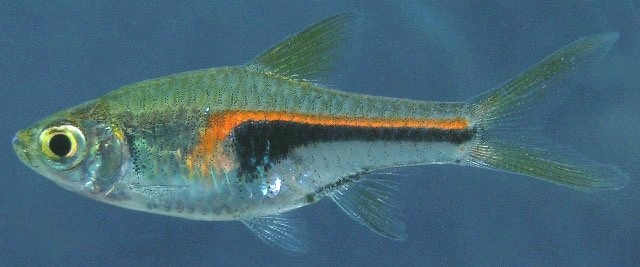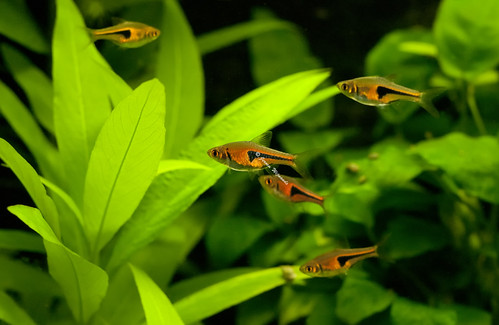After two weeks I had enough information to decide I needed to change a few things. The new location works out, temperature is much more stable. There was some algae on the tank walls which I wiped away with a piece of spunge. I've also added a few extra Malaysian Trumpet Snails to help keep it under control.
Plantwise, Pogostemon Helferi did surprisingly well. It was a bit less brilliant green and growth was slow but it had obviously taken. Hygrophila polysperma of which I was really worried last week has recovered and is slowly growing.The tiny anubias, which was a bit dodgy to begin with, wasn't working out all that well. I suspect these guys need a bit more light.
Now I'd read Diana's piece on shrimp bowls as well as a few other odds and ends and she always speaks highly of Echinodorus tenellus and likes Rotala rotundifolia as well. I read up on E. Tenellus and suspect it might do very well as a filler plant. I think it is going to form a dense forest quite easily.
I ended up ordering 3 pots of Echinodorus Tenellus and 1 pot of Rotala Rotundifolia for the grand total of 11 euros and 40 cents. For plants I've recently switched to aquaplantsonline.nl. Good plants at very decent prices. To prepare for the work I took the tank from it's place, drained 60% of the water and put it on the plastic IKEA serving tray I use for these jobs (easy to clean and keeps the table spotless).
E. Tellus:
Three shotglass sized plastic pots filled with rockwool. Obviously well rooted which is something I like to see when I buy plants. The one on the right was even flowering. Now, as most readers will know, when they arrive like this they're not suited to plant. In the pots they look terrible and if you plant them with the rockwool attached they'll take forever to settle in and spread. So, some disassembly is required:
Remove the pot and you see what you need to remove while damaging the roots as little as possible. Take note of what emerges above "ground"level, that's how they need to be planted. What works best is first work around the outside, pick of what goes easy. Then take a good look and see how many strands you have. Divide and pick the strands clean.
I ended up with 10 strands of E. Tellus out of 3 pots.
Rotala rotundifolia was more or less the same story only this plant doesn't do strands but has a more bush-like growth. Once again, pick it clean and take a good look. I decided to tear the bush in three and plant it out. After this I refilled the tank, put it back in it's place and let it settle. When you've done work it's tempting to grab the camera immediately. Bad idea, the water's likely to be cloudy and the plants need to find their positions.
In the back E.Tellus. Front left you can just see the curly leafs of a small Pogostemon Helferi and behind it the round leaves of Rotala Rotundifolia. Sticking out of the water on the left is a E. Tellus flower.
In a day or so I'll try to do a few overview shots and maybe a drawing of how I set it up. The curved walls make it difficult to do a good frontal overview shot.
Plantwise, Pogostemon Helferi did surprisingly well. It was a bit less brilliant green and growth was slow but it had obviously taken. Hygrophila polysperma of which I was really worried last week has recovered and is slowly growing.The tiny anubias, which was a bit dodgy to begin with, wasn't working out all that well. I suspect these guys need a bit more light.
Now I'd read Diana's piece on shrimp bowls as well as a few other odds and ends and she always speaks highly of Echinodorus tenellus and likes Rotala rotundifolia as well. I read up on E. Tenellus and suspect it might do very well as a filler plant. I think it is going to form a dense forest quite easily.
I ended up ordering 3 pots of Echinodorus Tenellus and 1 pot of Rotala Rotundifolia for the grand total of 11 euros and 40 cents. For plants I've recently switched to aquaplantsonline.nl. Good plants at very decent prices. To prepare for the work I took the tank from it's place, drained 60% of the water and put it on the plastic IKEA serving tray I use for these jobs (easy to clean and keeps the table spotless).
E. Tellus:
Three shotglass sized plastic pots filled with rockwool. Obviously well rooted which is something I like to see when I buy plants. The one on the right was even flowering. Now, as most readers will know, when they arrive like this they're not suited to plant. In the pots they look terrible and if you plant them with the rockwool attached they'll take forever to settle in and spread. So, some disassembly is required:
Remove the pot and you see what you need to remove while damaging the roots as little as possible. Take note of what emerges above "ground"level, that's how they need to be planted. What works best is first work around the outside, pick of what goes easy. Then take a good look and see how many strands you have. Divide and pick the strands clean.
I ended up with 10 strands of E. Tellus out of 3 pots.
Rotala rotundifolia was more or less the same story only this plant doesn't do strands but has a more bush-like growth. Once again, pick it clean and take a good look. I decided to tear the bush in three and plant it out. After this I refilled the tank, put it back in it's place and let it settle. When you've done work it's tempting to grab the camera immediately. Bad idea, the water's likely to be cloudy and the plants need to find their positions.
In the back E.Tellus. Front left you can just see the curly leafs of a small Pogostemon Helferi and behind it the round leaves of Rotala Rotundifolia. Sticking out of the water on the left is a E. Tellus flower.
In a day or so I'll try to do a few overview shots and maybe a drawing of how I set it up. The curved walls make it difficult to do a good frontal overview shot.



















